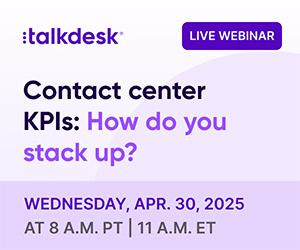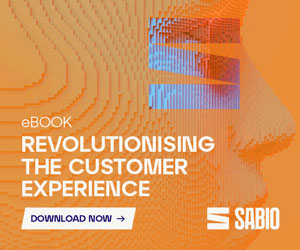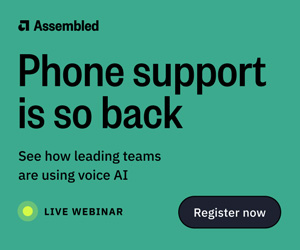Celia Cerdeira at Talkdesk explains how contact centre software can streamline customer service across various communication channels, providing a more personalized and efficient customer experience.
Customer service is easily one of the most important factors in determining a company’s success.
After a single positive experience with a brand, 91% of customers are more likely to purchase again. On the other hand, poor experiences cost companies $3.7 trillion annually in potential sales.
Contact centre software can streamline customer journeys and equip agents with the tools they need to resolve issues quickly and effectively.
It supports a variety of communication channels, from traditional phone calls to digital channels, ensuring customers can connect with brands in the way that best suits them.
Understanding contact centre software and how it works is key to unlocking its full potential.
This article will dive into the different types of contact centres, their unique capabilities, and how advanced technologies like artificial intelligence (AI) are revolutionizing customer service.
What Is a Contact Centre?
A contact centre is a department that manages customer interactions, which might include inbound or outbound communications with existing and potential customers.
Contact centre agents handle communication with customers across their preferred channels. While many customers choose to speak with live agents on the phone, modern contact centre infrastructure also allows for customer communication across various other channels, such as social media, online chat, video call, SMS, email, or a mobile app.
Customers today expect personalized experiences, whether responding to an email or conversing with a self-service chatbot.
Modern contact centre software typically relies on artificial intelligence (AI) to provide this level of personalization.
Contact Centre vs Call Centre: What’s the Difference?
Call centres used to be the standard for customer outreach. These physical offices employed agents to make or receive calls.
For example, teams of agents would field calls from customers wanting to return products or troubleshoot issues with a new purchase. Other teams handled information requests or various service inquiries.
The contact centre is the modern-day call centre, the next iteration in customer service. In fact, contact centres are notably more expansive than call centres.
They support personalized customer interactions across multiple communication channels, integrate with a company’s CRM platform and strategy, and provide a comprehensive view of customer data.
The most significant difference between a call centre and a contact centre is the customer experience they deliver.
Customers prefer spending less time on the phone, an issue traditional call centres can’t effectively address.
Modern contact centres, however, reduce both wait times and call times with advanced features like self-service chatbots and automated workflows.
Channel Options
Call centres are limited in the communication methods offered to customers. Contact centres are only limited by the channels a company wants to use.
Customers can reach out via SMS, email, voice call, video call, chat, mobile apps, and social media in addition to any self-service chatbot options.
Offering multiple communication channels makes outreach more convenient for customers. However, without proper internal tracking, it can be challenging to keep track of all the ways a customer engages with the company. AI and CRM integration can help.
Personalized Outreach
Customers now expect personalized sales interactions regardless of the industry, sales approach, or company size.
Research suggests 71% of customers expect some degree of personalization during brand interactions, and 76% become frustrated when they don’t receive it.
Personalized outreach often begins with conversational AI, allowing customers to feel seen and heard without needing to interact with a human agent.
If conversational AI can’t satisfy a customer’s request, it quickly redirects them to the next available agent.
Personalized outreach extends to each contact centre agent’s efforts. Customers expect accessible agents across various communication channels without long waits. They also expect agents to have access to their information once an interaction begins.
Depth of Customer Data
Communicating with customers across various channels generates a lot of data. Contact centres gather extensive information about customers and their behaviors, which agents can use to make future interactions more effective.
Managers can use this information to provide training on common customer challenges, preparing agents to handle expected issues.
Technological Sophistication
While call centre and contact centre technologies can overlap, contact centres often require cutting-edge technology beyond what call centres can offer. This includes:
- Automatic call distribution. Minimizes wait times and improves customer satisfaction by automatically routing calls to the right agent or resource on the first try.
- Channel reporting. Provides detailed reports on customer service proficiency against KPIs for each communication channel.
- Generative AI. Advances traditional IVR by allowing greater personalization and capturing customer sentiments for more accurate responses.
Generative AI also powers customer experience analytics, helping contact centre leadership identify trends and opportunities in the data they collect.
What Is an AI Contact Centre?
An AI contact centre combines AI technology with human input, transforming agent productivity, customer experience, and business insights.
AI features allow agents to spend less time doing repetitive tasks and more time addressing customer challenges. Generative AI delivers a frictionless, friendly customer experience and improves first contact resolution rates.
Other powerful AI contact centre capabilities include:
- Self-service. Generative AI powers conversational chatbots that help customers answer their questions, reducing queue wait times for customers with complex issues that require an agent.
- Omnichannel engagement. Customers can use their preferred channels, while AI aggregates data from across channels for full visibility.
- Workforce management. AI provides managers with practical tools that streamline staffing, scheduling, internal communication, and quality management. Non-technical contributors can build automation workflows in seconds.
- Employee collaboration. Integrate contact centre, phone system, and productivity tools to connect a workforce and the tech stack they use most frequently.
- Customer data collection. Collect and deliver actionable insights on customer behaviors and contact centre performance, allowing agents to improve customer interactions and measure KPIs against metric targets in real time.
What Is a Cloud Contact Centre?
A cloud contact centre is a customer outreach solution that securely stores data in the cloud. Without the need for on-premises hardware and software, a cloud contact centre relies on internet servers to gather, store, and access all customer information and communication threads.
This setup, known as contact centre as a service (CCaaS), involves platforms built and maintained in the cloud. CCaaS providers manage the software, ensuring it is always up-to-date and running smoothly.
This model eliminates the need for companies to purchase hardware, oversee upgrades, troubleshoot issues, and manage physical infrastructure.
As a result, it reduces costs and enhances scalability and flexibility, allowing businesses to adapt quickly to changing customer needs and market conditions.
Cloud contact centres are well-equipped to handle the largest priorities in modern customer service. They include features like customer relationship management (CRM) integrations, dashboard reporting, data security, and automation.
A cloud contact centre is typically operational relatively quickly after setup without needing the more extended installation, provisioning, configuration, and deployment processes typical with on-premises contact centres. Adding new agents to an existing cloud contact centre takes only a few minutes.
Here are a few features that set the top cloud contact centres apart:
- Pre-built integrations. Look for a platform with out-of-the-box integrations that allow companies to connect contact centre software to CRM software like Salesforce, project management tools, and other core industry applications.
- Low-code and custom-code tools. APIs, SDKs, and other development tools help accelerate customization processes to ensure the technology fits a specific organization’s or industry’s needs.
- Flexible deployment. A company can use its own carrier, storage deployment model, or regional cloud location to accommodate its business needs.
- Security certifications. Cloud contact centre solutions need security protocols accounting for regulations like HIPAA, General Data Protection Regulation (GDPR), and ISO 27001.
The best cloud contact centre systems also integrate AI automations that streamline functions like customer self-service, data visualization, and fraud detection.
What Are the Different Types of Contact Centres?
Contact centres often have overlapping capabilities. For example, an AI contact centre is typically also a cloud contact centre.
Outbound contact centres proactively reach out to potential customers for new leads while inbound contact centres handle inbound customer calls for product issues, new sales opportunities, or other service requests.
Let’s explore the most common contact centre types and capabilities.
Inbound Contact Centres
An inbound contact centre handles incoming calls, chats, and other messages from customers. Most messages are general customer service or technical support, where customers reach out for help with a product or service.
Inbound contact centres typically handle three types of calls:
- Orders and payments. Many customers prefer ordering products or services over the phone. Agents can facilitate these transactions and answer any questions before the purchase.
- Product and technical support. Customers seeking to return a damaged product or resolve an issue will often contact the original vendor for tech support.
- Updates to subscription-based services. With the popularity of subscription-based services, companies often receive high volumes of contacts from customers upgrading, renewing, or cancelling subscriptions.
Inbound contact centre success depends on their capacity to handle customer concerns effectively. Agents must provide the right answers to customers who may already be frustrated with their product or the hold time.
Companies commonly use the following metrics to gauge inbound contact centre performance:
- Average handle time. The total communication, hold, and after-interaction processing time an agent handles per customer.
- First contact resolution rate. The total number of customer interactions resolved correctly on the first attempt, divided by the total number of interactions in a given period.
- Average abandonment rate. The percentage of interactions that customers end after arriving in the queue.
- Average time in queue. The average time a customer spends waiting to speak with an agent across any outreach channel.
- Service level. The percentage of customer interactions addressed and missed during a set period.
Each of these KPIs contributes to the main goal of an inbound contact centre: improved customer satisfaction.
This metric is typically tracked as an aggregation of many others and helps stakeholders understand whether their level of customer service meets or exceeds customer expectations.
Outbound Contact Centres
An outbound contact centre handles proactive customer outreach. Unlike an inbound contact centre, where customers contact brands for answers, outbound contact centres have sales representatives calling prospects.
Some organizations also use outbound contact centres to conduct surveys or collect feedback after customer interactions.
Here are a few activities an outbound contact centre agent typically handles:
- Telemarketing. Despite its negative reputation, telemarketing plays an important role in sales. Telemarketers help spread brand and product awareness to new markets, generate leads, and familiarize potential customers with new solutions.
- Appointment setting. Agents often reach out to customers to set appointments with executives for follow-up. Outbound contact centres can also help set appointments for vehicle maintenance, patient visits, and other professional services.
- Market research. To better understand customer needs, outbound contact centres might ask people to answer survey questions or provide feedback on potential ideas to inform future lead generation efforts.
Because outbound contact centres proactively reach out to potential customers, they must follow strict compliance guidelines.
For example, in the U.S., customers can place their numbers on the National Do Not Call registry to opt out of sales and marketing outreach.
In Europe, companies must obtain consent from customers before contacting them, in compliance with the GDPR. Companies can receive substantial fines for contacting customers who have registered on this list.
Omnichannel Contact Centres
An omnichannel contact centre manages customer outreach across various channels. It offers customers multiple options for connecting with a brand, such as email assistance, chat support, and live help through social media messaging, in addition to traditional call services.
This increase in available channels gives customers more options for connecting with a company. However, it can also cause frustration if customers have to repeat themselves if they switch channels for the same issue.
Omnichannel contact centres can provide more effective customer support if they integrate data to prevent a disjointed experience.
Agents should have visibility into all of a customer’s interactions, regardless of the channel, to provide a seamless experience regardless of the channel.
Companies that use an omnichannel contact centre to personalize customer service see substantial returns.
Research shows a 9.5% year-over-year increase in overall revenue for these organizations, along with higher customer satisfaction and Net Promoter Scores (NPS).
Several features set an omnichannel contact centre apart from a traditional call centre:
- Integrated communication channels. Customers can seamlessly switch between channels without losing context between conversations.
- Detailed customer profiles. Every interaction between a customer and the business adds data to a comprehensive profile. This information helps agents provide accurate support based on the customer’s history.
- CRM integration. Omnichannel contact centres connect with CRM tools like Salesforce, giving a complete view of the customer’s profile. This integration makes contact centre data available for reference and navigation within the CRM.
- Contextual routing. Intelligent routing automatically assigns waiting customers to the next available agent qualified to handle their issues.
- Real-time reporting. Customer experience dashboards provide immediate insights, helping companies monitor service levels, staffing, and performance in real time.
The value of an omnichannel contact centre goes beyond the number of channels available to customers. With aggregated data from multiple channels, companies can improve internal performance.
Stakeholders can use agent data to identify areas for growth and ongoing training, making customer outreach more effective.
Virtual Contact Centres
Virtual contact centres typically consist of remote or hybrid agent teams and cloud contact centre software.
Virtual contact centres are an easily deployable, low-risk investment. Unlike traditional call centres, which require expensive infrastructure, using cloud technology eliminates the need for hardware.
Virtual contact centres can also make better use of agents in different locations. Agents in various time zones enable companies to extend their customer support hours. All they need is reliable internet access to start helping customers.
Virtual training and onboarding can be challenging, but the right software makes it easier. Agents can access customer data, scripts, and real-time information to answer questions, while managers can use this technology to track KPIs and monitor agent performance across locations.
Cloud Contact Centres: The Future of Customer Outreach
Cloud contact centres offer the best available customer support technology to benefit customers. AI enhances the contact centre environment by expanding communication channels, leveraging self-service options to reduce queue times, and preparing agents with customer profiles before interactions.
Every organization deserves a fast and reliable cloud-native customer experience platform. Custom workflow automation, flexible deployment options, and a low-code environment help reduce onboarding timelines and accommodate global data security standards. These features streamline customer support across all channels.
This blog post has been re-published by kind permission of Talkdesk – View the Original Article
For more information about Talkdesk - visit the Talkdesk Website
Call Centre Helper is not responsible for the content of these guest blog posts. The opinions expressed in this article are those of the author, and do not necessarily reflect those of Call Centre Helper.
Author: Talkdesk
Published On: 25th Jul 2024 - Last modified: 13th Jan 2025
Read more about - Guest Blogs, Celia Cerdeira, Talkdesk






 Talkdesk is a global customer experience leader for customer-obsessed companies. Our contact center solution provides a better way for businesses and customers to engage with one another.
Talkdesk is a global customer experience leader for customer-obsessed companies. Our contact center solution provides a better way for businesses and customers to engage with one another. 
































